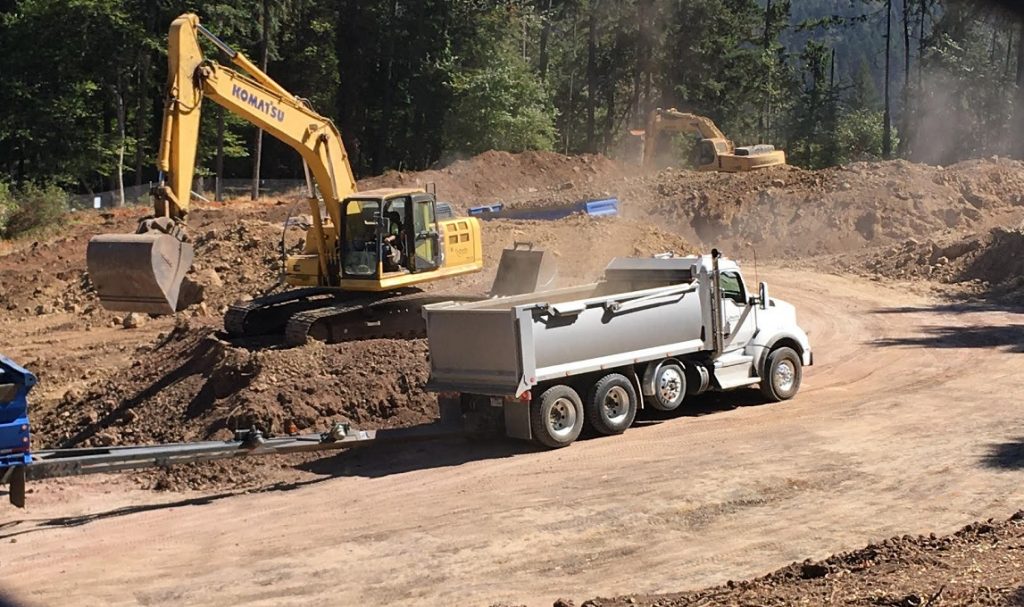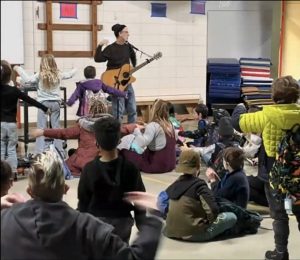Neighbors ask EWEB to stop spreading dirt, rocks from East 40th Project dump trucks
6 min read
A plume of dust is blown across the East 40th Water Project site. Photo courtesy Mark Robinowitz.
At the September EWEB board meeting, public comment focused on the East 40th project.
[00:00:07] Mark Robinowitz: Today of course, is the anniversary of the Holiday Farm Fire. I call it the Weyerhaeuser Fire, given where most of the burning was, and I have two questions for EWEB:
Has EWEB ever over the decades said anything about conversion of forests into the tree farms that were much more flammable?
I’m also curious if EWEB has ever objected to Weyerhaeuser Corporation spraying poison from helicopters over the McKenzie watershed, since that flows downstream into the drinking water intake?
And a suggestion. You’re about to appropriate a little more money for the contractor that has been clearcutting your reservoir site. It would be awfully nice if you require them to have covers for the dump trucks so they don’t spew dust all over South Eugene. And maybe you could use the water line you added to the site to wet down the dust. The air is officially unhealthy today in Eugene and at three o’clock this afternoon, the count in Fall Creek was 1,471, 1,471.
And I hope that all the commissioners and the senior staff at EWEB managed to take a look and smell your forest as it was being cut down. It’d be nice to consider that, you know, we’re not really such a green city in Eugene. We were formed cutting down one of the nicest forests on the planet and the distance from East 40th to your new compound in the West Eugene wetlands is the breathable thickness of the atmosphere. In other words, if you went seven miles straight up, you would no longer be able to breathe properly and everything we do in that thin film of the atmosphere will impact our great, great great-grandchildren. But of course you all know that.
Thank you for supporting
local citizen journalism
And finally, I appreciated the documents I got from the public records request, especially of the cracked walls in Hawkins Hill tank. And it suggests a lack of maintenance for a couple of decades. We’ve known about the subduction zone for over 35 years. And if these tanks were to break open in a seismic event, what would be the impact of downhill neighbors for Hawkins Hill or College Hill? And why is there no public discussion of that?
I would love to see EWEB provide a formal response about the dangers of these tanks to downhill neighbors.
[00:02:49] Marilyn Bloch: I’m Marilyn Bloch. I live in Ward Two and I wanted to comment on the contractor’s work up at 40th and Patterson. Starting off with the cutting down the trees. Pretty much all happened in one day. I heard that the time allotted to it was six to eight weeks and the trees were falling down on top of each other and cracking, breaking them, and good-sized trees were being ground up. And I’d heard ahead of time that you were going to make some into benches in the city, and I’d like to know how that project is going.
Also, I wanted to talk about the same thing that Mark did, about the trucks are not covered, and they’re not wetted down. So a friend followed one and got pelted with dirt and rocks and there’s dirt and rocks along the gutter heading down Hilyard. It’s adding pollution and I wonder if it’s even legal to do that. So I hope you can do something about covering them up. And also I’d like to know how much more money it’s going to cost so far to do this project. How much have you added to the project?
[00:04:21] Commissioner Sonya Carlson: Thank you both, appreciate the public testimony. Some good ideas in there. I definitely agree with looking at how to cover the the trucks and mitigate the impact there. I do think those things can be very dangerous with large gravel coming off and covering it, or, you know, wetting it down, if there’s a way to do that, we certainly don’t add any other pollution. And so I would be as supportive of staff reviewing what can be done there to make sure that impact is lightened in that community as much as possible.
[00:04:54] Commissioner Matt McRae: Very briefly I trust our project team will take a look at the dust complaints and make sure we’re doing all we can to mitigate the dust, rocks, and once it starts raining, the mud on that site. I trust we’ll do everything we can and appreciate the concerns being brought to us. The other one about the seismic comment about our reservoir, my understanding is that that is a primary driver for our fairly quick paced replacement of many of these exact reservoirs. Yes, they’re an issue and I think we are moving as quickly as we possibly can to eliminate, or at least substantially reduce that risk. Thanks for bringing it up.
[00:05:30] Commissioner John Barofsky: Thank you. And thank you for your testimony people. One of the questions was how much more money are we spending in addition to what’s already been budgeted. That’s an item that’s coming up in our consent calendar. And a couple of them go directly to some of the concerns that were raised in public comment. There’s an increase of about $9,000 for rock that we put up on the site to cut down on the dust so that when the heavy equipment’s moving around, it’s not pushing up a lot of dust. I know that doesn’t specifically speak to the dust that’s coming off of the trucks, but it was a increased cost that we felt was well worth it.
We also spent a couple thousand dollars to have the crews leave some snags for habitat, for wildlife up there.
And then the rate payers incurred a rather substantial cost of about $24,000 for the delay that was imposed on us by the stay. We had to pay the contractors that were there to basically not work and that was almost a $24,000 hit to our rate payers. So that’s where the increase in the budget. That’s going to be coming up in our consent calendar.
[00:06:48] Frank Lawson: Commissioners, this is Frank Lawson, for the record. I will reiterate that throughout the course of this project staff will continue to, and I think as Commissioner McRae stated, we’ll continue to look at the protocols for mitigating noise, for mitigating dust, later mud, and a number of other construction-related activities. It’s very unlikely that we will cover dump trucks. That’s pretty impractical, but some of the other things mentioned are a possibility: how we load those, to what extent, and to some other protocols relative to keeping the dust down. So there’s some things, but staff will continue to monitor the protocols at the East 40th site and try to mitigate those things that impact neighbors as we go forward as best we can.
[00:07:31] John Q: Commissioner Barofsky had a request.
[00:07:34] Commissioner John Barofsky: in the past month or so, my business has been targeted by some people that weren’t happy with the decision that I made as an EWEB commissioner regarding the 40th and Hilyard water tanks. I just want to let people know that this has been a real difficult time for my industry as a whole, and our business in particular. And I just hope that moving forward people will keep my business, and my employees that I’ve tried to employ through this difficult period, separate from my position as an EWEB commissioner, and the decisions that I need to make. I just hope that that’s something we can keep separate in the time moving forward. And that’s all I’d like to say. Thank you.



